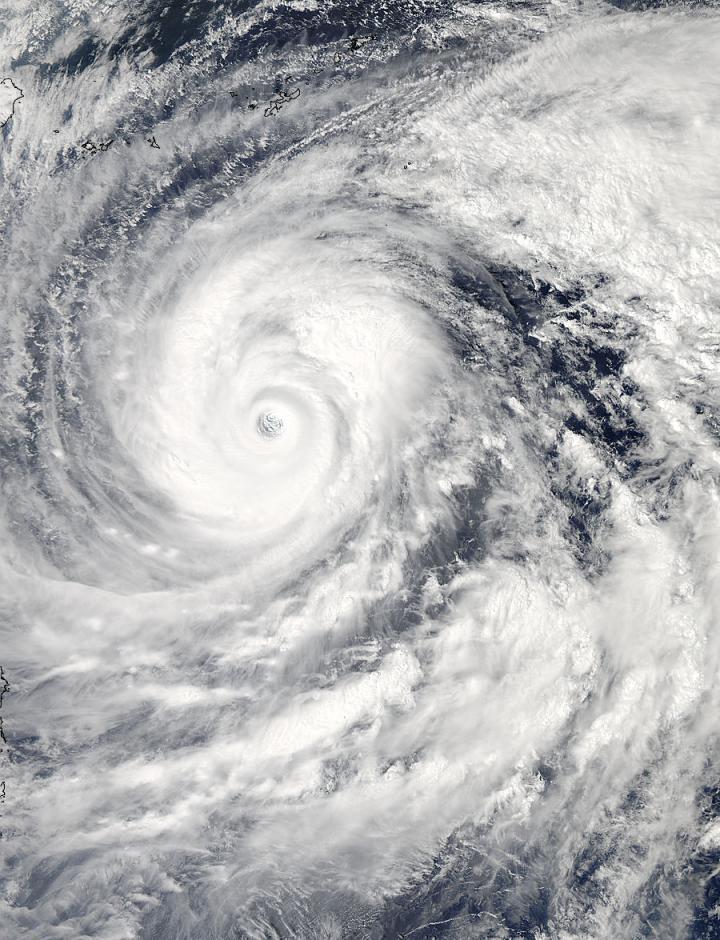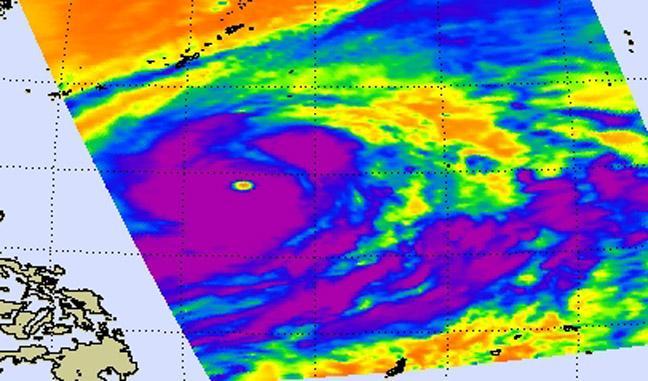NASA's Aqua satellite passed over Super Typhoon Vongfong as it tracked through the Philippine Sea on Oct. 9. Instrument aboard Aqua captured visible and infrared images of the now Category 4 Super Typhoon.
Two instruments aboard NASA's Aqua satellite provided visible and infrared data on the Super Typhoon: The Moderate Resolution Imaging Spectroradiometer or MODIS and the Atmospheric Infrared Sounder or AIRS instrument, respectively. MODIS captured a visible image of Super Typhoon Vongfong on Oct. 9 at 04:25 UTC (12:25 a.m. EDT) that showed two concentric eyewalls with the inner eye diameter at 26 nautical miles. Forecasters at the Joint Typhoon Warning Center noted that the eye remains symmetrical with sharp outlines - typical of very intense cyclones. The AIRS data showed the overall cloud top temperatures had warmed a little since yesterday, Oct. 8, indicating that the uplift in the storm may be weakening. AIRS also showed a thick band of powerful thunderstorms surrounded Vongfong's eye.

The MODIS instrument aboard NASA's Aqua satellite captured this visible image of Super Typhoon Vongfong on Oct. 9 at 04:25 UTC (12:25 a.m. EDT as it moved north through the Philippine Sea.
(Photo Credit: NASA Goddard MODIS Rapid Response Team)
Vongfong weakened to a Category 4 typhoon on the Saffir-Simpson scale on Thursday, October 9, with maximum sustained winds near 130 knots (149.6 mph/240.8 kph), down from a Category 5 typhoon on Oct. 8. Forecasters at the Joint Typhoon Warning Center predict slow weakening over the next several days.
Vongfong was centered near 20.6 north and 129.5 east, about 384 nautical miles south-southeast of Kadena Air Base, Okinawa, Japan. It is moving to the north-northwest at 7 knots (8 mph/12.9 kph) and generating 44 foot (13.4 meter) high seas. For warnings and watches, visit the Japan Meteorological Agency website at: http://www.jma.go.jp/en/typh/.
Vongfong is forecast to continue moving north through the Philippine Sea and is expected to pass just to the east of Kadena Air Base, then track over Amami Oshima before making landfall in Kyushu and moving over the other three big islands of Japan. Residents of all of these islands should prepare for typhoon conditions beginning on October 10.

The AIRS instrument aboard NASA's Aqua satellite captured infrared data on Super Typhoon Vongfong and showed powerful thunderstorms (purple) circled the center in a wide band on Oct. 9, 2014.
(Photo Credit: NASA JPL, Ed Olsen)
Source: NASA/Goddard Space Flight Center